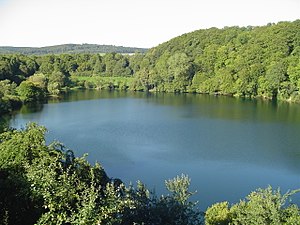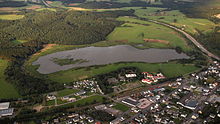Ulmen Maar
| Ulmen Maar | ||
|---|---|---|

|
||
| Looking north from the Oberburg castle ruins | ||
| Geographical location | Rhineland-Palatinate , Germany | |
| Tributaries |
Roman tunnel (from the Jungferweiher ), Ulmener Bach (artificial, since 1875) |
|
| Drain | drainless | |
| Places on the shore | Elms | |
| Data | ||
| Coordinates | 50 ° 12 '36 " N , 6 ° 58' 59" E | |
|
|
||
| Altitude above sea level | 440 m | |
| length | 510 m | |
| width | 250 m | |
| scope | 900 m | |
| Maximum depth | 37 m | |
The Ulmener Maar is a maar in the Eifel in the immediate vicinity of the town of Ulmen in Rhineland-Palatinate . The lake is up to 37 meters deep and is enclosed by an average 20 meter high wall made of tuff , which was formed from the ejection of the former volcano. On the southern edge of the wall are the ruins of a knight's castle from the 11th century .
geology
The Ulmener Maar has an irregular shape, it measures about 510 meters in north-west-south-east direction and 250 meters across it. The crater created by the volcanic eruption is up to 86 meters deep. Rocks are of the crater walls above the water Devonian open , it is of the Maar enclosing Tuffwall. The tuffs consist of volcanic ejecta material ( pyroclastic sediments such as volcanic ash and lapilli ) as well as rock shattered during the eruption.
The Ulmener Maar is considered to be the youngest of the Eifel maars, it was only formed after the eruption of the Laacher See volcano . Dating using varven chronology showed an age of 11,000 years. The dating of organic remains at the base of the volcanic tuffs belonging to the maar using the radiocarbon method , however, varies between 7,335 and 10,920 years for the determined age, based on further geological evidence, an age of around 9,500 years to a maximum of 12,400 years is assumed. Younger age values are only known from the Booser Doppelmaar , but here the dates are even further apart, between 6,275 and 35,240 years. The age of the Booser Doppelmaar is estimated at around 10,100 to 14,160 years. Volcanologists from the Smithsonian Institution place the last eruption of the Ulmen Maar in the period from 8890 to 8590 BC. A.
The north of Ulmen Maar located bridesmaid pond is also a Maar , but a verlandetes . Drilling has shown that it is the remains of a 118,000 year old volcano , which was much larger than the one from which the Ulmener Maar emerged. In 1942, the water was dammed up on the marshy meadows, creating a body of water again, on the northern part of which there is now a bird sanctuary where you can observe rare and endangered birds. Because of its abundance of fish, the lake also attracts many anglers .
The legends of the Ulmen Maar
There are many stories and legends about the maar , most of which refer to the knights of the castle enthroned above. One of the best known is that of the giant fish in the maar. It is said that every time he was seen, one of the lords of the castle died.
The forecast was in 1542 by the Basel scholar Sebastian Münster written:
- "Items two well-known lakes are in this Eyfel / one at the Elmen Castle / and the other at the Closter for spawning / they are very deep / have no river / but a lot of outflow / they are called Mahr / and are rich in fish. In the Mahr zu Ulmen there is a fish / how then I saw a lot / on thirty shanks long / and one and 'onf twelve shoeheads long / she stabled pike. And if they let themselves see / die an inheritance of the house Ulmen / it be man or Fraw / is often guarded and experienced. These ages are common on high mountains. One has wanted to request that to Ulmen in its depth / and after having lowered dz Bley three hundred claws deep / one has found no reason to like. "
In today's German:
- “There are also two well-known lakes in this Eifel, one at Ulmen Castle and the other at Laach Monastery. They are very deep, have no inflow, but a strong outflow. They are called maars and they are rich in fish. In the Maar at Ulmen there is a fish that many have seen, it is thirty feet long, and another is twelve feet long, they are shaped like a pike. And if they show up, a legacy of the Elmen family will certainly die , be it man or woman. This has been observed and experienced many times. These maars are usually located on high mountains. One wanted to examine the elms in depth, and after having lowered the lead three hundred fathoms , one could not find a reason. "
See also
literature
- Werner D'hein : Nature and culture guide Vulkanlandeifel. With 26 stations on the "German Volcano Road". Gaasterland-Verlag, Düsseldorf 2006, ISBN 3-935873-15-8 .
Web links
References and footnotes
- ↑ OpenTopoMap
- ↑ From maar to maar underground
- ^ Project study "Ulmener Burg, Maar & Weiher". (PDF; 4.1 kB) University of Trier, 2011, archived from the original on January 3, 2014 ; accessed on December 2, 2015 (presentation of the project).
- ↑ Hans-Ulrich Schmincke: Volcanoes of the Eifel . Spektrum Akademischer Verlag, Heidelberg 2009, ISBN 978-3-8274-2366-5 , p. 34.
- ^ Wilhelm Meyer: Geology of the Eifel. 614 pp., Schweizerbart'sche Verlagsbuchhandlung, Stuttgart 1986, ISBN 3-510-65127-8 .
- ↑ Lee Siebert, Tom Simkin and Paul Kimberly: Volcanoes of the World . 3. Edition. Smithsonian Institution / University of California Press, Washington, Berkeley, Los Angeles, London 2010, ISBN 978-0-520-26877-7 , pp. 50 .
- ↑ Westeifel-Vulkanfeld in the database of the Smithsonian Institution, s. v. Eruptive history
- ↑ 1 foot corresponds to 28 to 32 cm.



